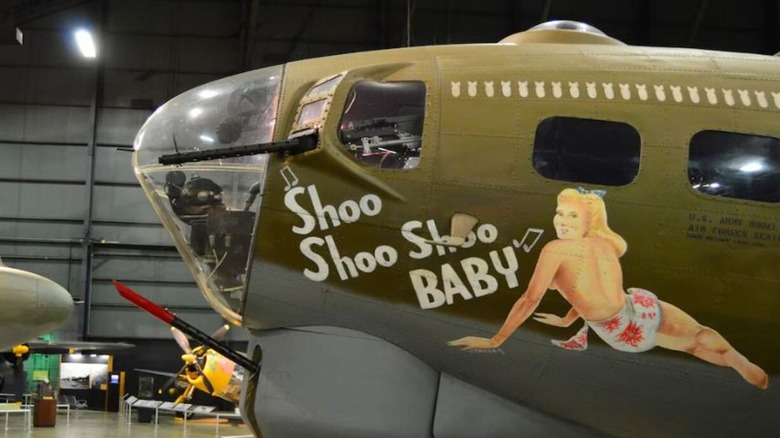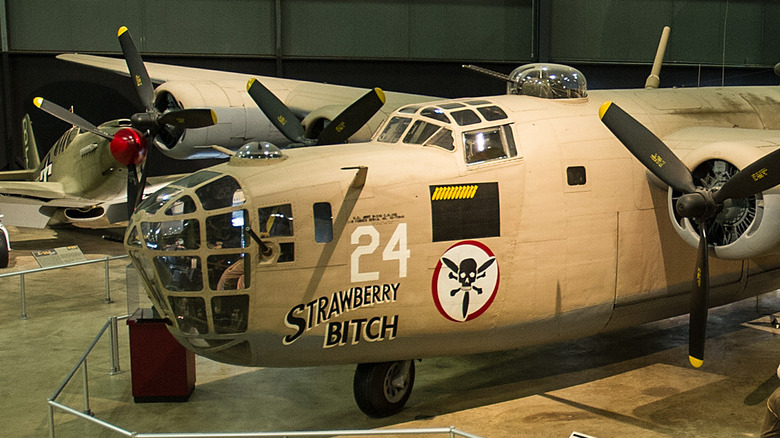What Do The Bomb Markings On The Side Of Military Aircraft Mean?
Because of their role in both strategic and tactical deployments, bombers are a crucial asset for air forces. Bombers target infrastructure that can cripple an opponent's industrial capabilities, disrupt supply lines, and help create a path for ground offensives. During World War II, bombers were a vital component of the Allied war effort by serving as a highly versatile weapon that could both directly help coordinated operations and diminish an enemy's ability to continue fighting, which contributed to Allied victory. An interesting feature of both old and new bombers is the drawings or markings of bombs on their sides, which represent mission symbols or kill marks.
These illustrations essentially serve as a visual documentation of the accomplishments of aircraft and its crew, and are normally found on the fuselage of bomber aircraft, on its port side, usually near the nose or cockpit. For bomber aircraft, the bomb drawings are called a bomb tally, and each color or illustration can represent several things, including the area of operation, the type of bombs used, or a milestone earned. Aside from bombs, other symbols used include destroyed enemy ships, planes, or even other targets, like trains or missiles, signifying the defeat of these hostile targets during operations.
The origins of kill markings on aircraft can be traced to the World War I, where fighter aircraft and aerial warfare were first used on a large scale. In the early stages of the war, pilots used small arms like pistols and rifles, but as technology improved, creating more advanced aircraft, kill markings emerged as a way to identify the unit affiliation and the aircraft pilot. Later on, the design of kill marks became more varied as more countries adopted their symbolic use.
A badge of honor and perfomance
Kill markings and mission symbols are among what is termed as "nose art" for military aircraft. These artworks depict decorative paintings or figures that were intended to personalize the aircraft and raise crew morale, particularly during times of war. Nose art gained popularity during World War II, especially among bomber crews who grew close to their planes and wanted to express themselves with these ornaments. Because of its customized nature, nose art on aircraft featured humorous, sentimental, and suggestive designs
World War II–era bombers that featured these bomb markings include aircraft like the B-24 Liberator (pictured above), the legendary B-17 Flying Fortress, and the Avro Lancaster bomber. Modern aircraft that have been seen with the bomb marks are the A-10 Warthog and one of the very first stealth aircraft, the F-117 Nighthawk. Alongside aircraft, naval vessels that fought in World War II also had kill marks. This practice was borrowed from naval planes and adapted to include ships, which exhibited their achievements by displaying the silhouettes of defeated and sunk enemy vessels. Today, U.S. naval forces continue to use victory marks as symbols for successful engagements.
The evolution of aircraft technology has made contemporary bombers even more lethal and effective, as exemplified by the highly advanced B-2 Spirit stealth bomber. While more advanced than its predecessors from the two World Wars, the bomber's role remains the same, and with this comes the tradition of adorning the aircraft with victory markings. Although the majority of U.S. military aircraft, including bombers, no longer fly victory or kill marks as they did during previous conflicts such as World War II, some units continue to do so in certain situations, mainly to commemorate successful encounters.

